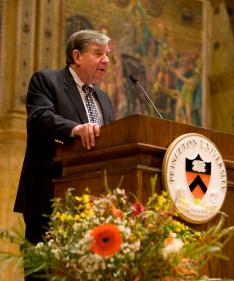Publications, higher-ed leaders recall the influence of the former Princeton president
Former President William G. Bowen *58, who died Oct. 20, will be remembered at a campus memorial service on Dec. 11 at 1:30 p.m. in the University Chapel. In the last five days, many publications and leaders in higher education have written about Bowen’s contributions to both Princeton and the wider higher-ed community. See below for links to a selection of those stories.
Add your recollections of President Bowen to those posted by PAW readers, or contact us at paw@princeton.edu
- In a release from the University, President Eisgruber ’83, an undergraduate during Bowen’s presidency, said, “Bill was ever the teacher, and he mentored large numbers of scholars, policy experts and higher education leaders. I feel fortunate to have been in that group.” — Princeton.edu
- A New York Times obituary highlighted Bowen’s work to diversify the student body at Princeton during his time as provost and president. — The New York Times
- The Washington Post also noted Bowen’s role in an era of change at Princeton and pointed to the influence of the books he wrote after leaving Nassau Hall. — The Washington Post
- “Beyond the brilliance, beyond the incomparable wit, there runs through the course of Bill’s career an almost matchless capacity for empathy,” wrote Brian Rosenberg, president of Macalester College, in an online remembrance. — The Chronicle of Higher Education
- Doug Lederman ’84 of Inside Higher Ed wrote that Bowen was a rare example of a major university president who was able to “influence higher education more after they leave office than while they are in it.” — Inside Higher Ed
- Bowen was “the man who shed light on why college keeps getting more expensive,” according to NPR, which cited an influential 1966 study by Bowen and fellow economist William J. Baumol. — NPR
- Jeffrey J. Selingo, a former editor of The Chronicle of Higher Education, recalled Bowen as “a giant in academe even in his last years of life.” — The Chronicle of Higher Education

